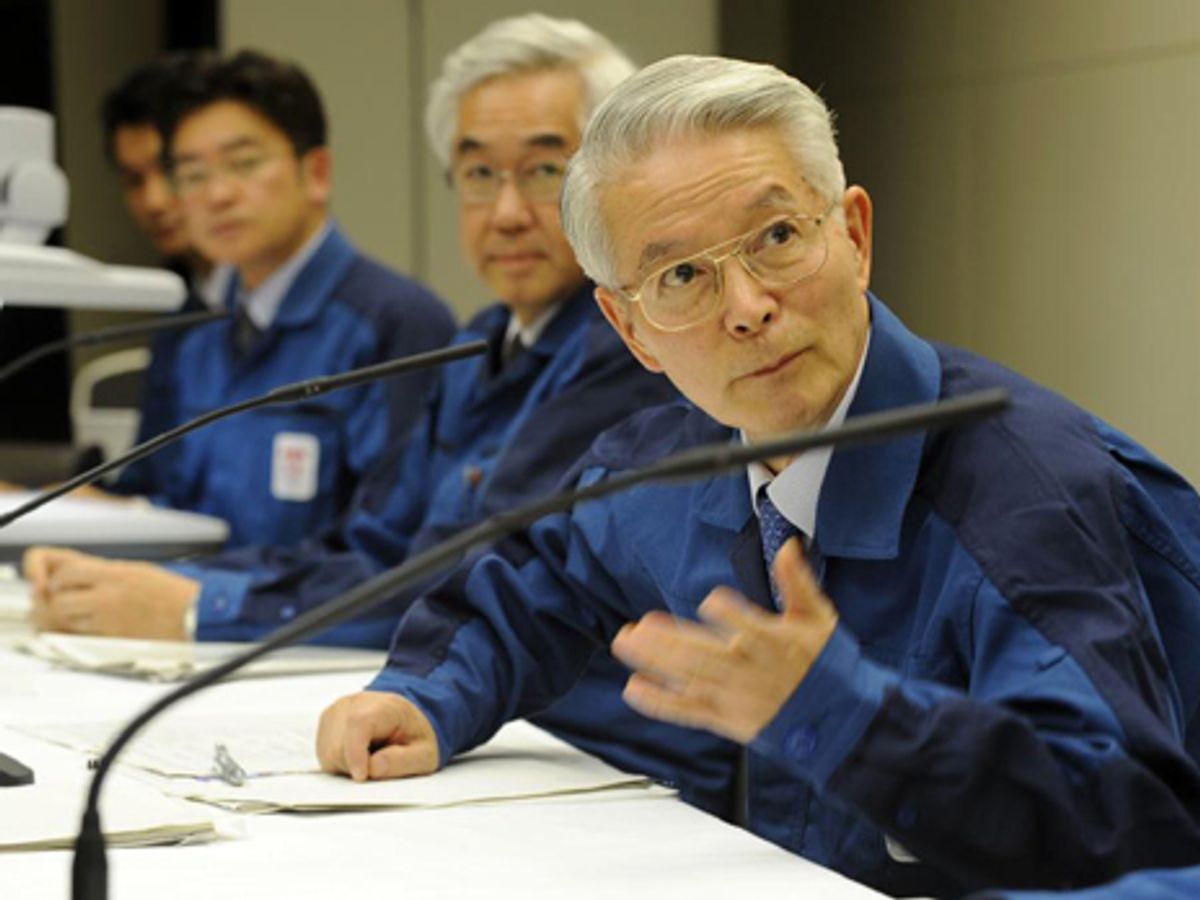Editor's Note: John Boyd is an IEEE Spectrum contributor reporting from Kawasaki, Japan. This is part of IEEE Spectrum's ongoing coverage of Japan's earthquake and nuclear emergency. For more details on how Fukushima Dai-1's nuclear reactors work and what has gone wrong so far, see our explainer.
On Sunday, Tokyo Electric Power Co. (TEPCO) announced its plan for stabilizing the crippled Fukushima Dai-1 nuclear power plant and gaining control of the radioactive emissions that have hindered repair work and forced well over 100 000 people to evacuate the area.
Speaking to reporters in Tokyo, company chairman Tsunehisa Katsumata and other officials outlined a two-step plan to achieve a cold shutdown within nine months. The "roadmap towards restoration" is the first such plan TEPCO has revealed since the March 11 earthquake and tsunami.
The first phase of the project, which will take place over the next three months, includes a number of maneuvers that are intended to prevent further accidents at the reactors. To maintain and enhance cooling of the three damaged reactors, workers will continue to flood the containment vessels with fresh water. To prevent hydrogen explosions, workers will continue injecting nitrogen gas into the pressure vessel of the No. 1 reactor, and begin injecting nitrogen into the pressure vessels of the Nos. 2 and 3 reactors. Ongoing efforts to keep the spent fuel storage pools filled will also continue. These efforts will be followed with the installation of “stable cooling circulation systems,” details of which are still being worked out, but which will be either air- or water-based.
The first phase of TEPCO's plan also includes efforts to halt the spread of radioactive materials. To prevent radiation-contaminated water from escaping the confines of the plant, TEPCO will install additional storage containers for the radioactive water that has been pooling in the turbine basements and outside trenches. The company then plans to begin decontaminating water that is only mildly radioactive, so it can be reused to help cool the reactors and spent fuel storage pools.
The company will continue to spray a plastic emulsion it has been using to prevent radioactive dust at the site from dispersing further. Another step will be to install coverings on the damaged reactor buildings to help prevent further releases of radioactive materials into the atmosphere; again, officials said the details of that procedure are still being worked out. To guard against further ocean pollution, TEPCO will place silt fences near the outflow pipes of some reactors, and will also install steel plates in the artificial lagoon that surrounds the ocean side of reactors.
TEPCO will also continue to use radio-controlled equipment to remove radioactive debris that resulted from two hydrogen explosions in the first week of the crisis. And in a new development, remote-controlled robots were sent into the highly radioactive reactor buildings over the weekend to take radiation, temperature, and pressure readings; the bots also recorded video footage of the conditions that repair crews will eventually have deal with.
In the plan's second phase, which TEPCO says can be accomplished in six to nine months, the company will reinforce the earlier measures to achieve a cold shutdown--a stable situation in which coolant water in the reactors is flowing at less than 100 degrees Celsius. The company said it will also work with the government to help decontaminate the evacuation area, to enable the eventual return of some of the residents who were forced to flee.
TEPCO officials said this timetable was tentative and could change, given “the various uncertainties and risks” involved. The company also pointed out that to even begin the process of a cold shutdown, workers first have to remove the radioactive water--estimated to be as much as 60 000 tons--pooled in the turbine basements and outside trenches of the three reactor buildings. This in itself is proving to be a colossal task.
Last week Hidehiko Nishiyama, deputy director-general of the Nuclear and Industrial Safety Agency (NISA), initially reported that TEPCO had pumped several hundred tons of highly radioactive water from the trench outside the Unit 2 turbine building into a storage vessel, causing the water level in the trench’s shaft to drop and decreasing the possibility of it spilling over. But the following day he said the water level had begun edging up again, and in a Sunday press conference he noted the “water was now rising steadily, so we need to hurry with transferring this water to the wastewater treatment facility.” This facility, he explained, was currently being prepared for the transfer, and the pumping operation would begin “in a few days.” The No. 2 reactor has been leaking dangerously radioactive water, and is thought to be more critically damaged than the other reactors.
One expert who spoke to Spectrum was not fully convinced TEPCO could meet the timetable it has set itself to achieve a cold shutdown. “Unfortunately, they are adding to (the pooled radioactive) water every day because it is leaking from the reactors,” says Kazuaki Matsui, executive director of the Institute of Applied Energy, an independent research group. “So it is a difficult task. Maybe they can achieve a cold shutdown for reactors 1 and 3 (according to the schedule set) but I’m not sure about No. 2, which has a hole in the suppression pool chamber (torus) and so may take longer.”
PHOTOS: Sankei/Getty Images; TEPCO






